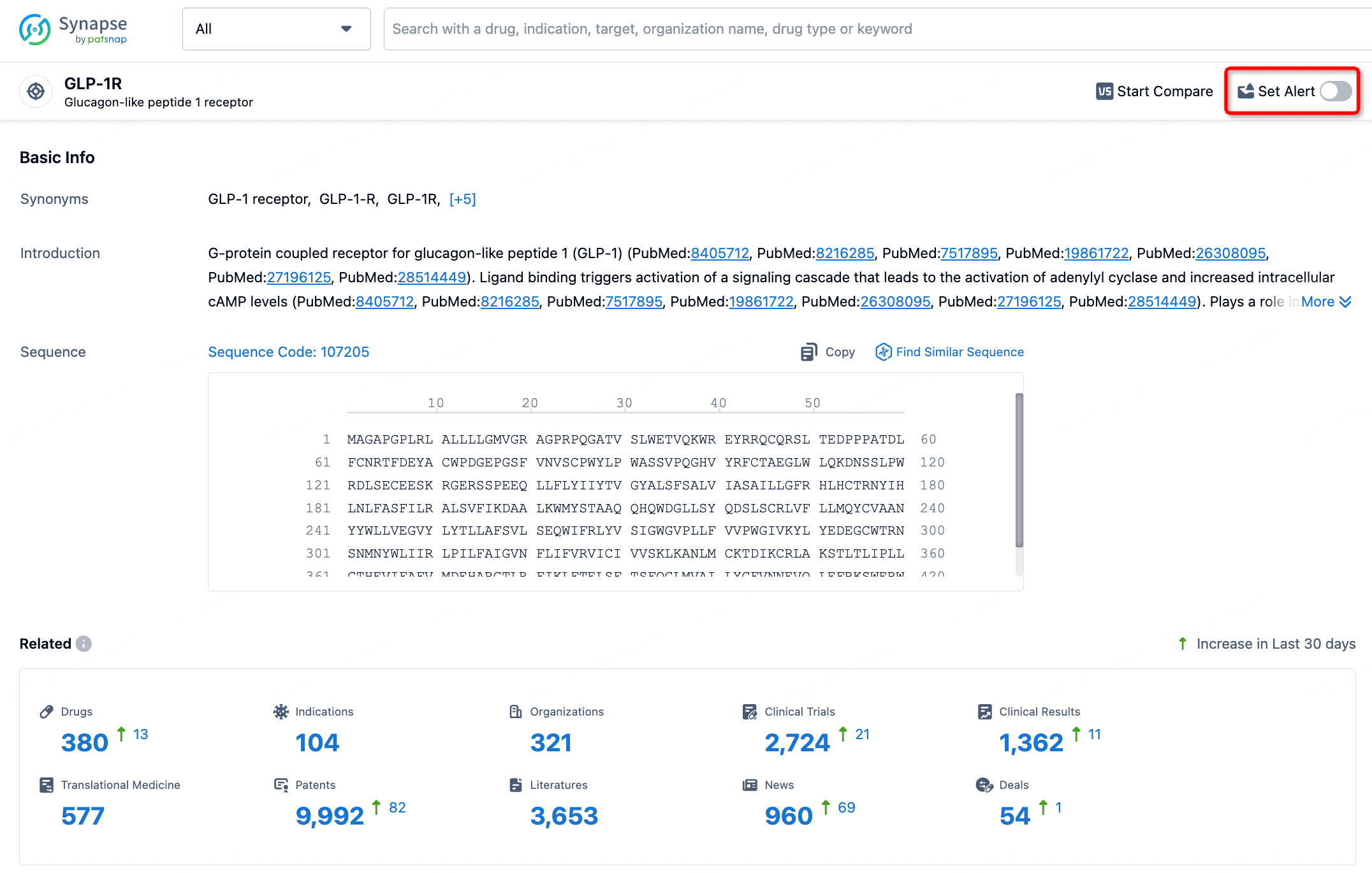Request Demo
What are NPTXR inhibitors and how do they work?
25 June 2024
Neuronal Pentraxin Receptor (NPTXR) inhibitors are an emerging class of compounds that hold significant promise in the field of neuroscience and neuropharmacology. NPTXR is a member of the pentraxin family of proteins, which are primarily known for their role in the immune response and neural functions. This blog post aims to provide a comprehensive understanding of NPTXR inhibitors, detailing their mechanism of action and potential therapeutic applications.
NPTXR inhibitors are designed to modulate the activity of the NPTXR protein. NPTXR is predominantly expressed in the brain and plays a critical role in synapse formation and maintenance. It is involved in the clustering of AMPA receptors at the synapse, which are essential for synaptic plasticity and transmission. By inhibiting NPTXR, these compounds can potentially alter synaptic functions, thereby influencing various neural pathways.
NPTXR inhibitors work by binding to the NPTXR protein and preventing its interaction with other synaptic components. This inhibition disrupts the normal functioning of NPTXR, which can lead to a decrease in AMPA receptor clustering at the synapse. As a result, synaptic transmission and plasticity are altered. The exact binding site and inhibitory mechanism may vary depending on the specific inhibitor, but the primary goal is to attenuate the synaptic effects mediated by NPTXR.
Additionally, recent studies have shown that NPTXR inhibitors can modulate neuroinflammatory responses. NPTXR is known to interact with various inflammatory cytokines and signaling pathways. By inhibiting NPTXR, these compounds can potentially reduce neuroinflammation, which is a common feature in many neurodegenerative diseases. This dual action on synaptic and inflammatory pathways makes NPTXR inhibitors a versatile tool in addressing a range of neurological conditions.
NPTXR inhibitors have shown promise in preclinical studies for the treatment of several neurological disorders. One of the primary areas of interest is Alzheimer's disease (AD). In AD, synaptic dysfunction and neuroinflammation are prominent features. By modulating these pathways, NPTXR inhibitors could potentially slow down or halt the progression of the disease. Early animal studies have demonstrated that these inhibitors can improve cognitive function and reduce amyloid-beta plaque formation, a hallmark of Alzheimer's disease.
Another potential application of NPTXR inhibitors is in the treatment of epilepsy. Epileptic seizures are often associated with abnormal synaptic activity and neurotransmitter release. By altering synaptic transmission, NPTXR inhibitors can potentially reduce the frequency and severity of seizures. Preclinical models have shown that these inhibitors can provide anticonvulsant effects, paving the way for further research in clinical settings.
Moreover, NPTXR inhibitors are being explored for their potential in treating mood disorders such as depression and anxiety. Synaptic plasticity and neurotransmitter balance play crucial roles in mood regulation. By modulating synaptic functions, NPTXR inhibitors may offer a novel approach to managing these conditions. Preliminary studies have suggested that these inhibitors can exert antidepressant and anxiolytic effects, highlighting their therapeutic potential.
In addition to these applications, researchers are investigating the use of NPTXR inhibitors in neurodevelopmental disorders such as autism spectrum disorder (ASD) and schizophrenia. These conditions are often characterized by synaptic abnormalities and altered neural connectivity. By targeting NPTXR, researchers hope to correct these synaptic deficits and improve cognitive and behavioral outcomes.
Despite the promising preclinical data, it is essential to note that NPTXR inhibitors are still in the early stages of development. Further research is needed to fully understand their safety, efficacy, and potential side effects in humans. Clinical trials will be crucial in determining the therapeutic value of these inhibitors and their suitability for widespread use.
In conclusion, NPTXR inhibitors represent a promising avenue for the treatment of various neurological disorders. By targeting the synaptic and inflammatory pathways mediated by NPTXR, these compounds have the potential to address conditions ranging from Alzheimer's disease to epilepsy and mood disorders. As research progresses, we may see these inhibitors becoming integral components of future therapeutic strategies in neuropharmacology.
NPTXR inhibitors are designed to modulate the activity of the NPTXR protein. NPTXR is predominantly expressed in the brain and plays a critical role in synapse formation and maintenance. It is involved in the clustering of AMPA receptors at the synapse, which are essential for synaptic plasticity and transmission. By inhibiting NPTXR, these compounds can potentially alter synaptic functions, thereby influencing various neural pathways.
NPTXR inhibitors work by binding to the NPTXR protein and preventing its interaction with other synaptic components. This inhibition disrupts the normal functioning of NPTXR, which can lead to a decrease in AMPA receptor clustering at the synapse. As a result, synaptic transmission and plasticity are altered. The exact binding site and inhibitory mechanism may vary depending on the specific inhibitor, but the primary goal is to attenuate the synaptic effects mediated by NPTXR.
Additionally, recent studies have shown that NPTXR inhibitors can modulate neuroinflammatory responses. NPTXR is known to interact with various inflammatory cytokines and signaling pathways. By inhibiting NPTXR, these compounds can potentially reduce neuroinflammation, which is a common feature in many neurodegenerative diseases. This dual action on synaptic and inflammatory pathways makes NPTXR inhibitors a versatile tool in addressing a range of neurological conditions.
NPTXR inhibitors have shown promise in preclinical studies for the treatment of several neurological disorders. One of the primary areas of interest is Alzheimer's disease (AD). In AD, synaptic dysfunction and neuroinflammation are prominent features. By modulating these pathways, NPTXR inhibitors could potentially slow down or halt the progression of the disease. Early animal studies have demonstrated that these inhibitors can improve cognitive function and reduce amyloid-beta plaque formation, a hallmark of Alzheimer's disease.
Another potential application of NPTXR inhibitors is in the treatment of epilepsy. Epileptic seizures are often associated with abnormal synaptic activity and neurotransmitter release. By altering synaptic transmission, NPTXR inhibitors can potentially reduce the frequency and severity of seizures. Preclinical models have shown that these inhibitors can provide anticonvulsant effects, paving the way for further research in clinical settings.
Moreover, NPTXR inhibitors are being explored for their potential in treating mood disorders such as depression and anxiety. Synaptic plasticity and neurotransmitter balance play crucial roles in mood regulation. By modulating synaptic functions, NPTXR inhibitors may offer a novel approach to managing these conditions. Preliminary studies have suggested that these inhibitors can exert antidepressant and anxiolytic effects, highlighting their therapeutic potential.
In addition to these applications, researchers are investigating the use of NPTXR inhibitors in neurodevelopmental disorders such as autism spectrum disorder (ASD) and schizophrenia. These conditions are often characterized by synaptic abnormalities and altered neural connectivity. By targeting NPTXR, researchers hope to correct these synaptic deficits and improve cognitive and behavioral outcomes.
Despite the promising preclinical data, it is essential to note that NPTXR inhibitors are still in the early stages of development. Further research is needed to fully understand their safety, efficacy, and potential side effects in humans. Clinical trials will be crucial in determining the therapeutic value of these inhibitors and their suitability for widespread use.
In conclusion, NPTXR inhibitors represent a promising avenue for the treatment of various neurological disorders. By targeting the synaptic and inflammatory pathways mediated by NPTXR, these compounds have the potential to address conditions ranging from Alzheimer's disease to epilepsy and mood disorders. As research progresses, we may see these inhibitors becoming integral components of future therapeutic strategies in neuropharmacology.
How to obtain the latest development progress of all targets?
In the Synapse database, you can stay updated on the latest research and development advances of all targets. This service is accessible anytime and anywhere, with updates available daily or weekly. Use the "Set Alert" function to stay informed. Click on the image below to embark on a brand new journey of drug discovery!
AI Agents Built for Biopharma Breakthroughs
Accelerate discovery. Empower decisions. Transform outcomes.
Get started for free today!
Accelerate Strategic R&D decision making with Synapse, PatSnap’s AI-powered Connected Innovation Intelligence Platform Built for Life Sciences Professionals.
Start your data trial now!
Synapse data is also accessible to external entities via APIs or data packages. Empower better decisions with the latest in pharmaceutical intelligence.


